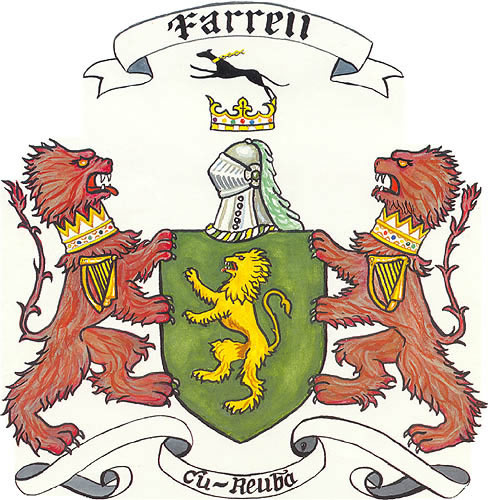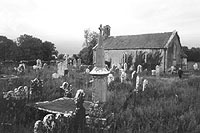Longford, Ireland - The Ferrels' Ancestral Home

Situated in the Midlands at heart of Ireland lies County Longford. The area is a rolling landscap of farm land and pastures for grazing cattle, wetlands and bogs. The town of Longford is a bustling community of rougly 6,000 inhabitants and is the county seat. Though the O’Farrells were in the area before the town was established, the town originated with the O’Farrell stronghold around 1400, with the village springing up around in protection of the fort.
Fearghal, King of Conmacne, Powerful Grandfather of the O’Farrells
Princes of Annaly, Men of Valor
The Farrell chieftains were Princes of Annaly (O Fearghaill - Gaelic) descendants of Fearghal, King of Conmacne, lord of a vast empire surrounding the Longford area of Ireland. They were the ruling family of Annaly and some of the surrounding counties for over five hundred years and are mentioned in the Annals of the Four Masters. The name of their fortification was Longphuirt Ul Fhearghail, or “Farrell Fortress.’ The named evolved to be Longford. Their crest states “Prodesse Non Nocere” - to do good not evil. Fearghal, which means Men of Valor, was slain at the Battle of Clontarf (Dublin) in 1014. Fearghal's descendants would change the surname to O’Farrell. The Farrells (and the land) were divided into two branches, the O’Farrell Boy (yellow) and O’Farrell Bane (fair). Our Ferrels would have come from the O’Farrell Boy, the protestant arm of the family. O’Farrells were prominent in the affairs of the Longford area into the 17th century and Farrell remains the most prominent family name in county Longford today.
It is clear that our Ferrels left Ireland prior to 1740 when Gabriel Ferrel first appeared in the American colonies in Virginia, maybe even as early as the time of Cromwell’s invasion of Ireland or during the time of King James I.
Ruins of Farrell Castle - Ancient Walls Hold Past Glories
Possibly occupied between the 14th and 16th centuries, the Farrell castle (also called Mornin Castle) is situated in the midlands about six miles outside of Longford Town, Ireland. On the right side of the structure, the arched doorway is visible. The castle is solidly constructed with two-foot-thick rock walls. Though the castle sits on solid ground, the area surrounding it is bog land. For scale, on close inspection of the photo below, you can see a person (me) looking into the arched doorway. Once inside, looking up at the ceiling above the inside doorway, there is a hole about one foot square. This hole is common to many castles, including this type of tower castle. The opening is for viewing from above those entering the castle below. Friend or foe makes a big difference. This opening is called a “murder hole” and was used to stop those who were not welcome before they could proceed any further into the castle. By comparing this to other similar tower castles, we can assume that the lower floor was mainly a gathering place. The second floor was likely the dining area, the third floor the kitchen, and the upper floors would have been for sleeping. Tower castles were used for lookouts and to send warnings. If a castle was under attack, a fire would be built atop the castle, and could be seen for about fifty miles to the next tower castle. In ancient times, tower castles were spaced about fifty miles apart and the ruins can be seen periodically as you travel throughout Ireland.
a big difference. This opening is called a “murder hole” and was used to stop those who were not welcome before they could proceed any further into the castle. By comparing this to other similar tower castles, we can assume that the lower floor was mainly a gathering place. The second floor was likely the dining area, the third floor the kitchen, and the upper floors would have been for sleeping. Tower castles were used for lookouts and to send warnings. If a castle was under attack, a fire would be built atop the castle, and could be seen for about fifty miles to the next tower castle. In ancient times, tower castles were spaced about fifty miles apart and the ruins can be seen periodically as you travel throughout Ireland.
To the left of the entrance is the opening to a very narrow and tightly spiraling rock staircase. The stairs spiral upward in a clockwise fashion for a purpose. If you are a right handed intruder ascending the stairs, you must turn your body to expose more of it to use your sword, making you more vulnerable and a bigger target to those above.
A couple of years ago, according to the current landowner who has had the castle in his family for the last 100 years (the previous owner had it for 300 years), a cow wandered inside the castle entrance and attempted to go up the spiral staircase. Cows will go up but not back down stairs, and so a large hole had to be punched into the inside wall of the second level staircase to lower the cow to the castle floor.
The old Fortress in Longford Town still houses the remains of the original Farrell settlement marketplace. The fort is used today as a military outpost. Across the street from the fort is the Church of Ireland, an old church where several Farrells were martyred during Cromwell’s time. Many other interesting sites remain in the Longford area if you are ever in the market for a wonderful trip. Ireland is a place like no other! Go if you can.
Moydow Church Last Resting Place of Many Farrells
of Many Farrells
Old, Moydow church cemetery is the last resting place of many Farrells. (Farrell is catholic and Ferrel is protestant). The oldest headstone here is dated 1640. The church is located about two miles from the ruins of Farrell Castle. This photo was taken during my visit to Ireland to explore and discover more about the wonderful history of our family, October 2001.